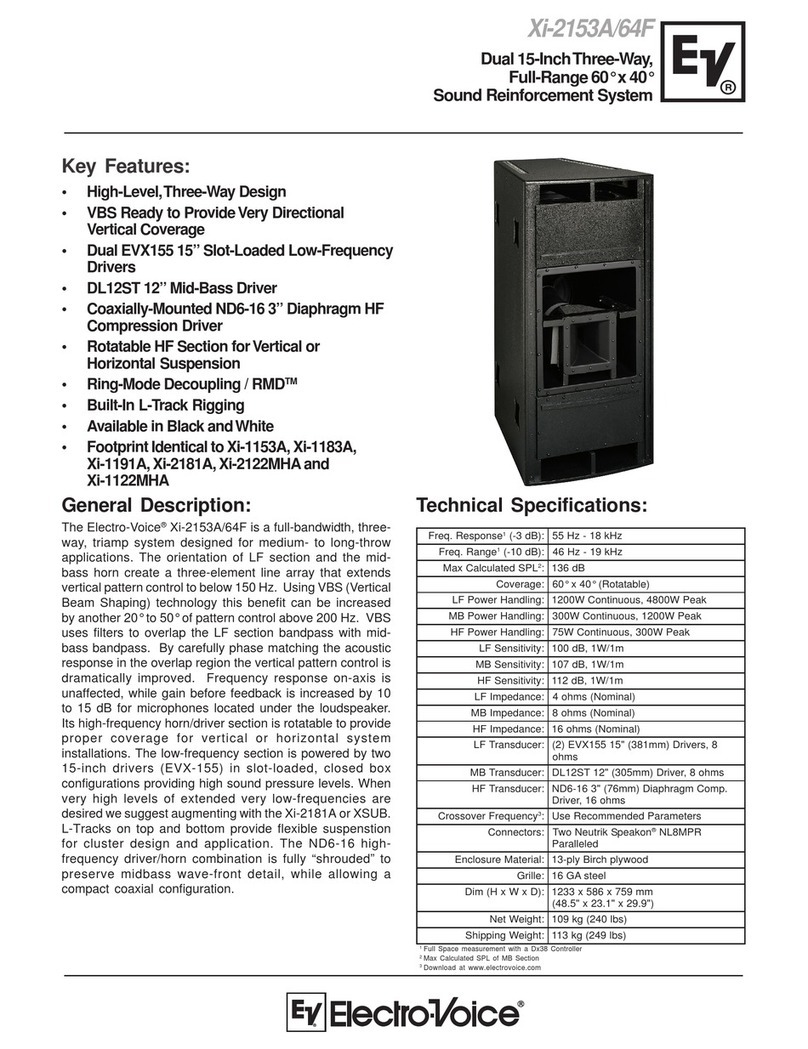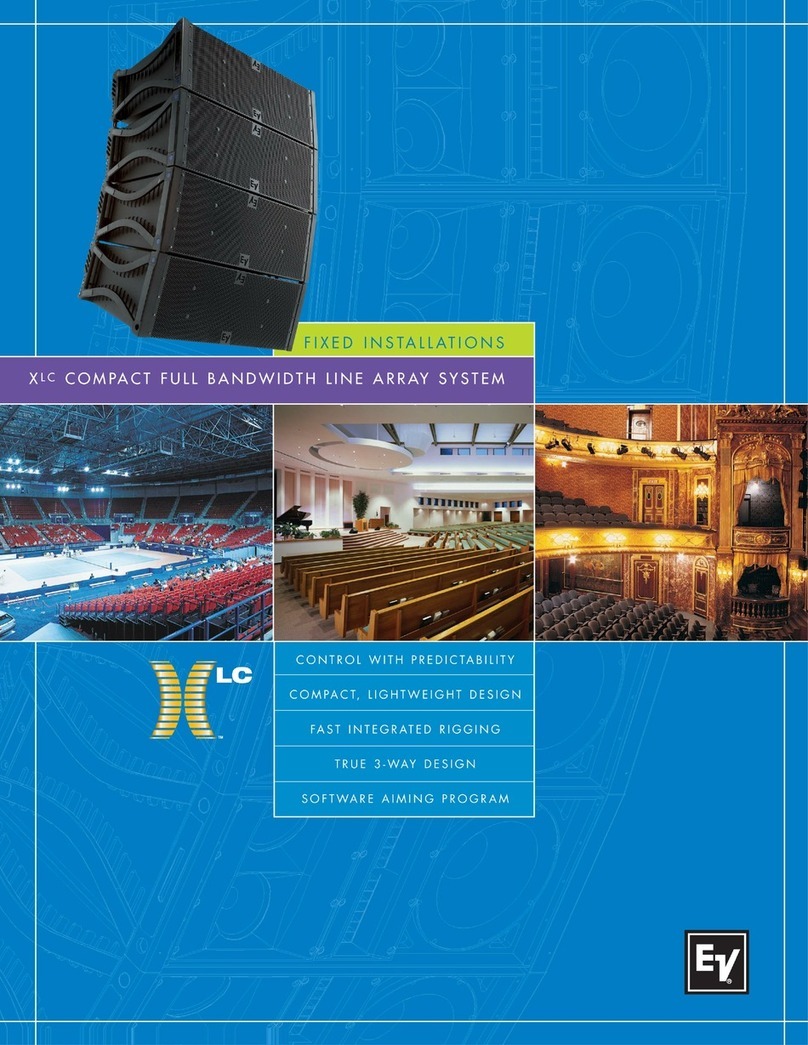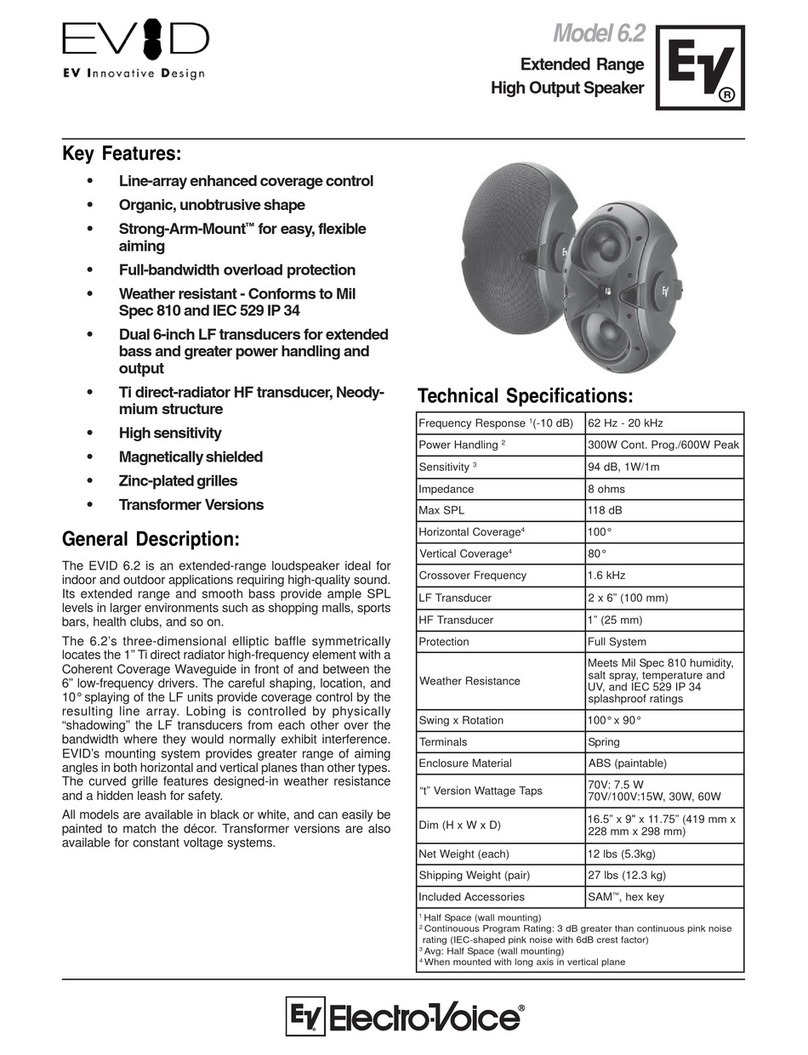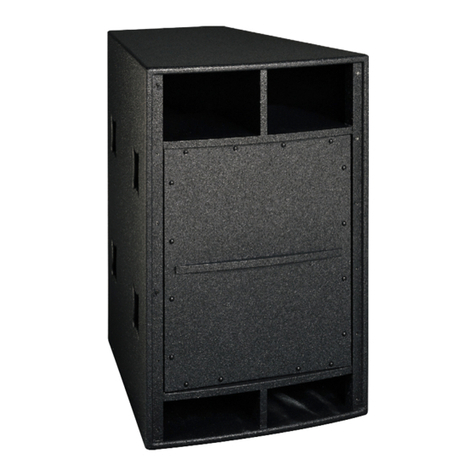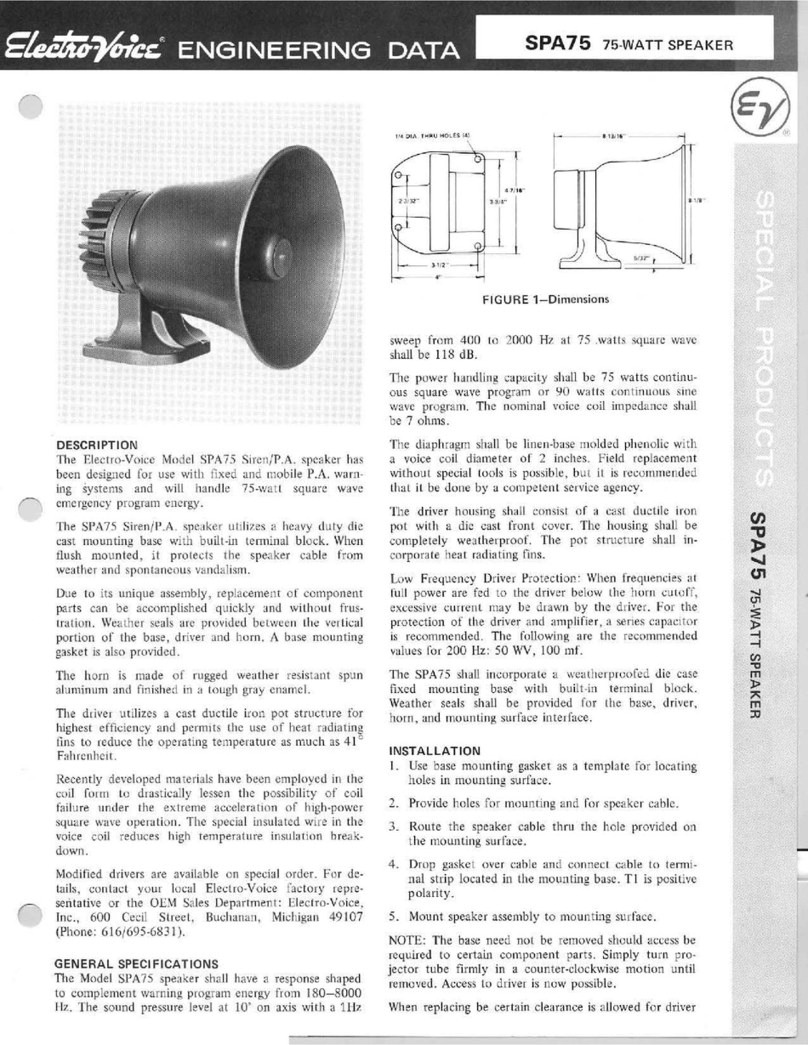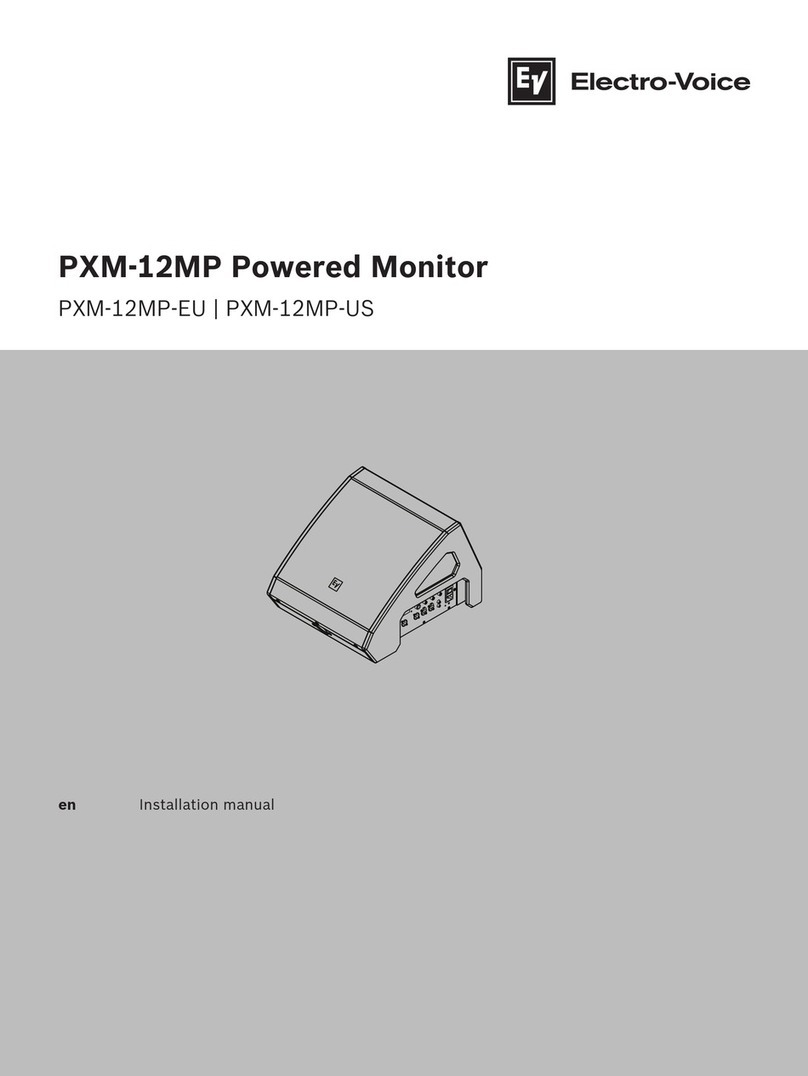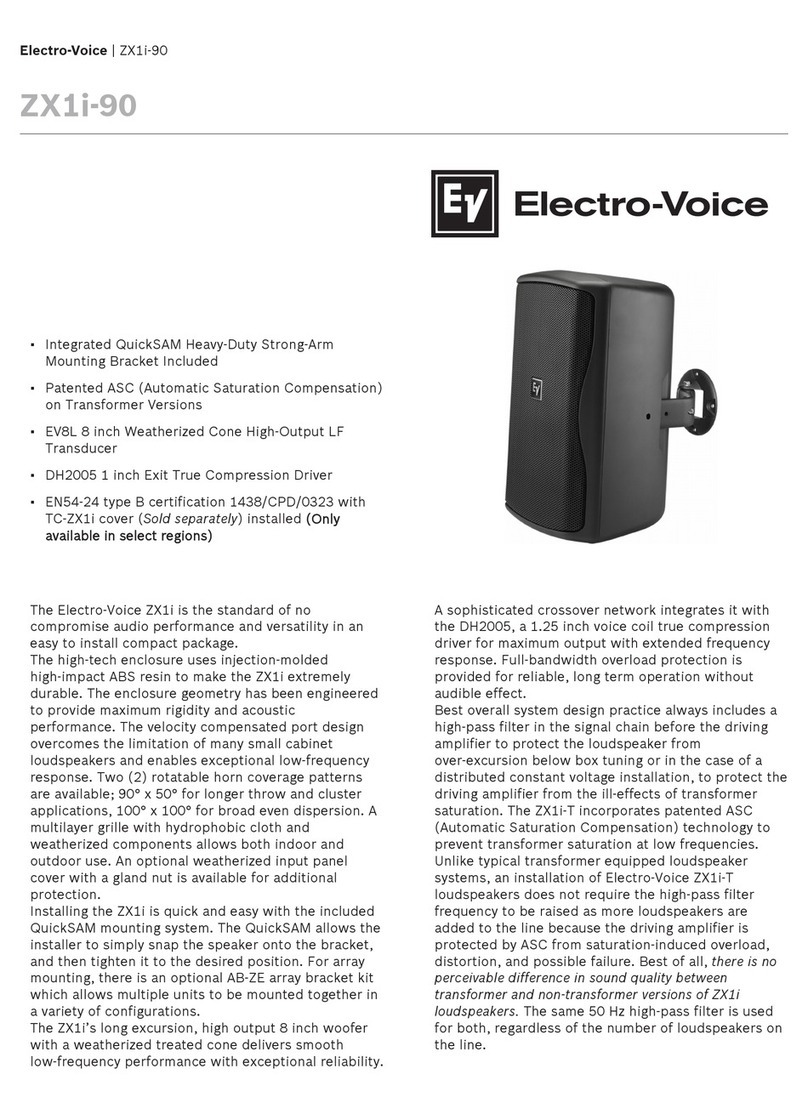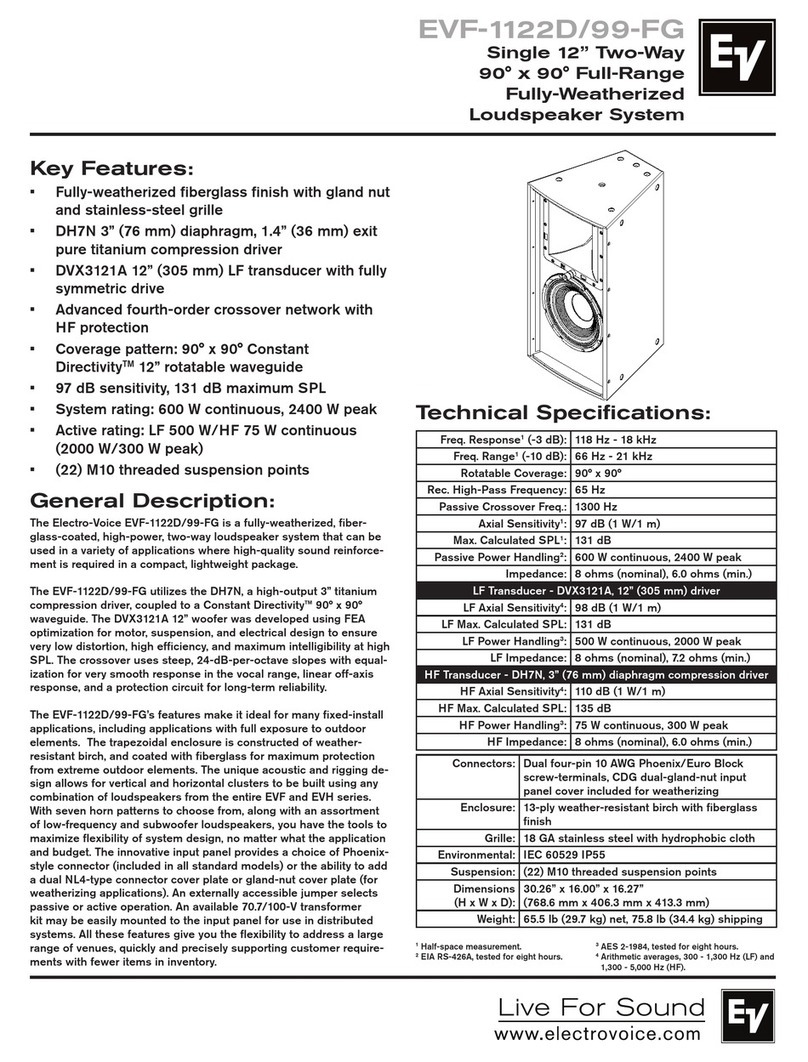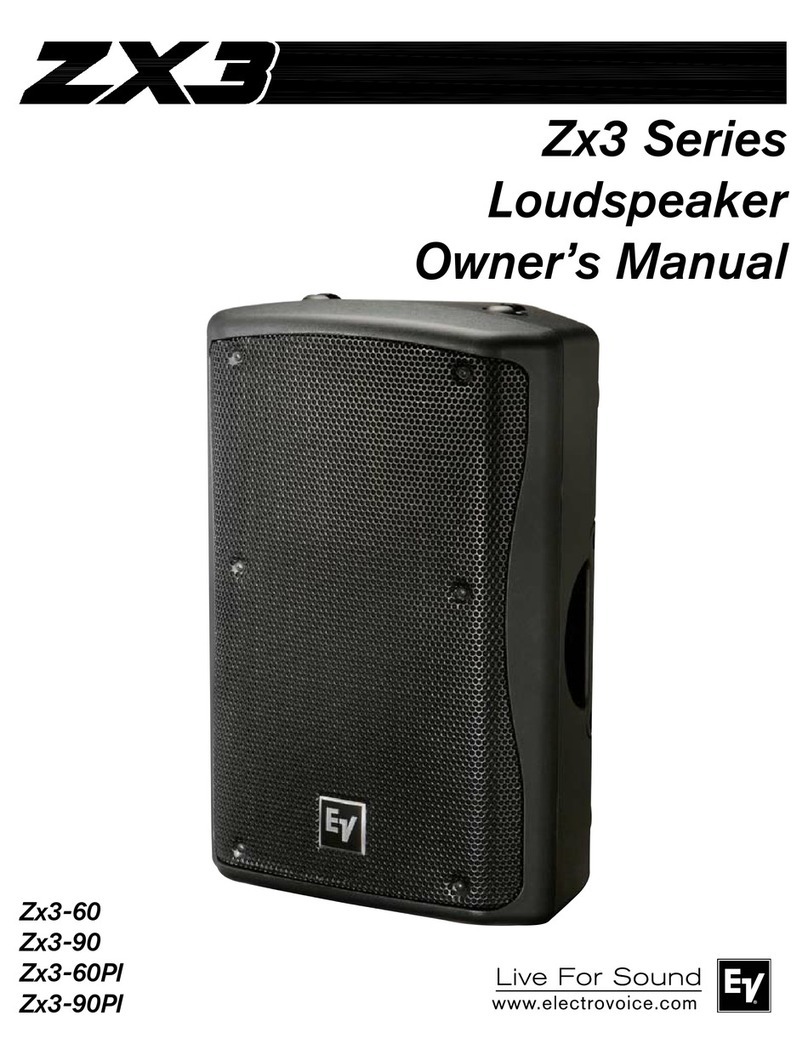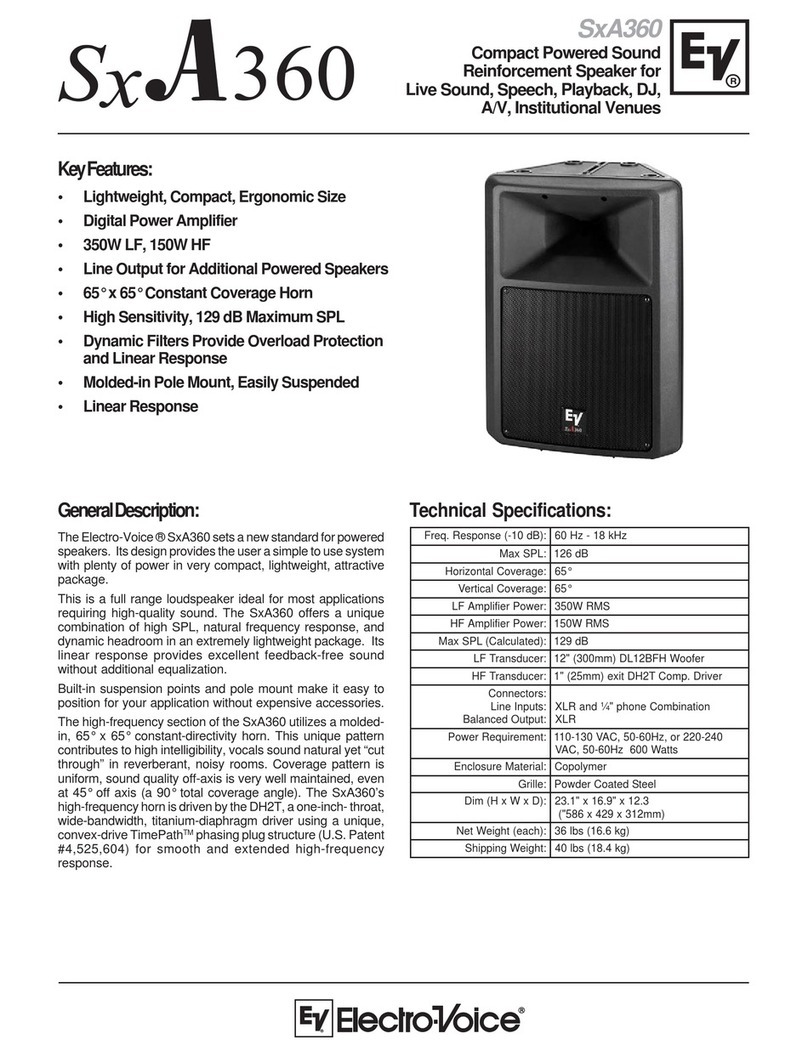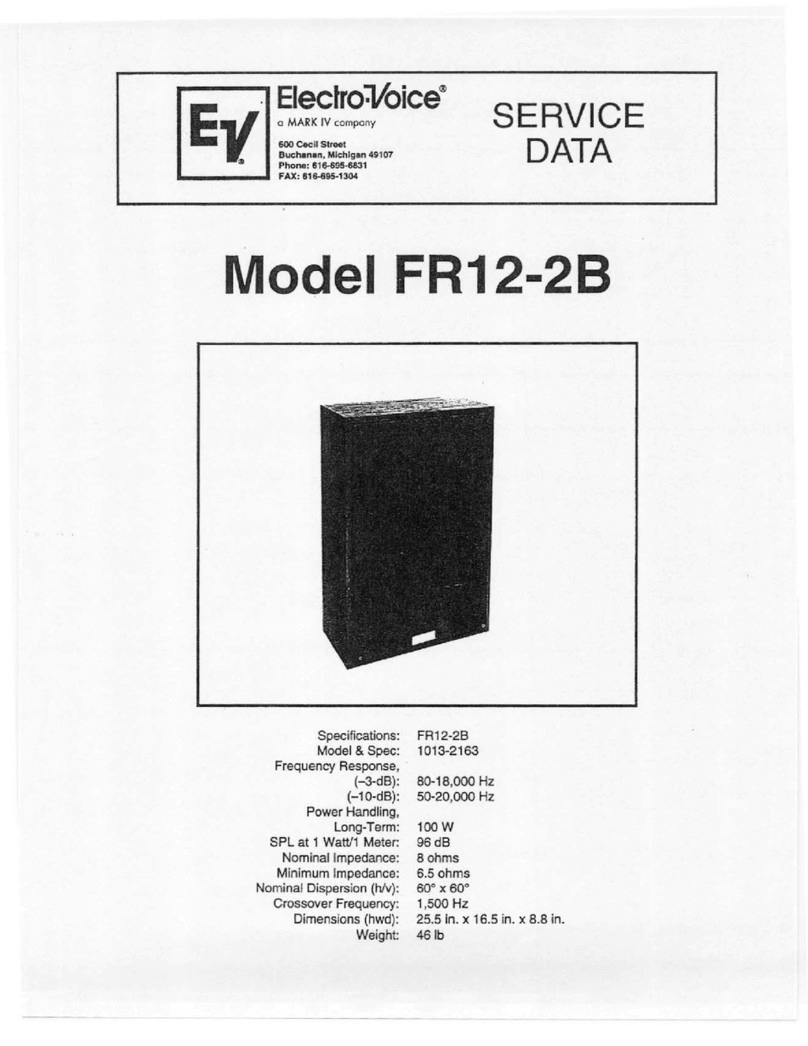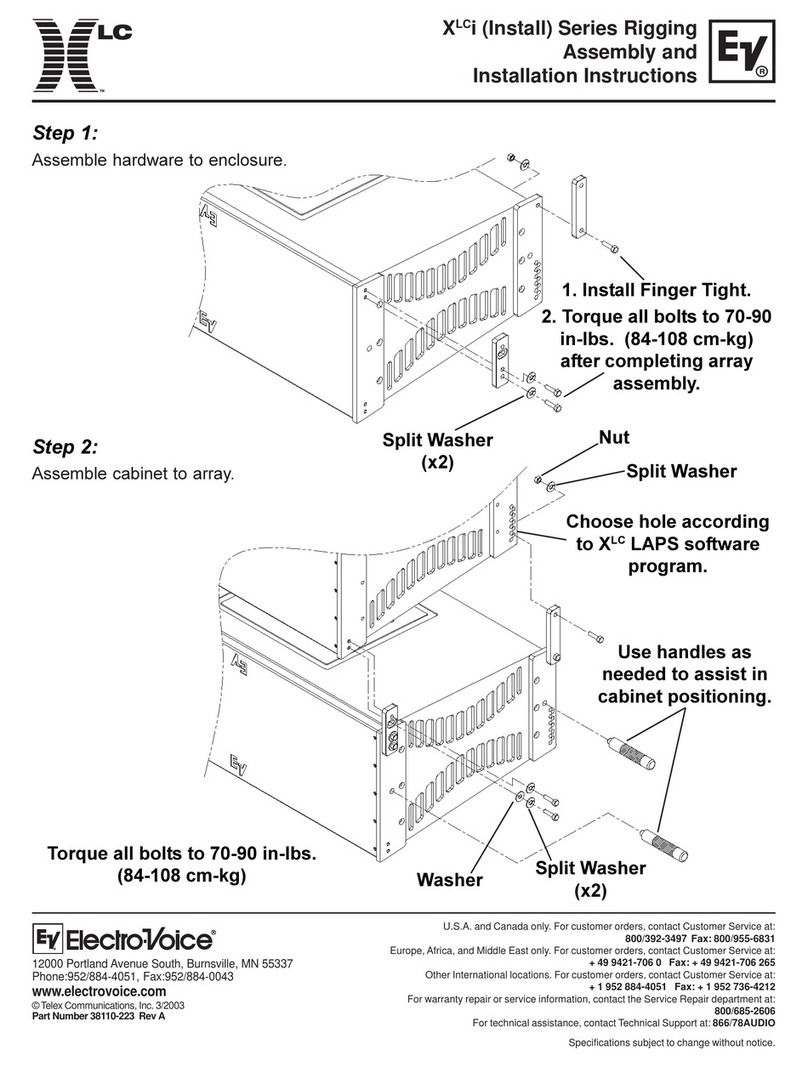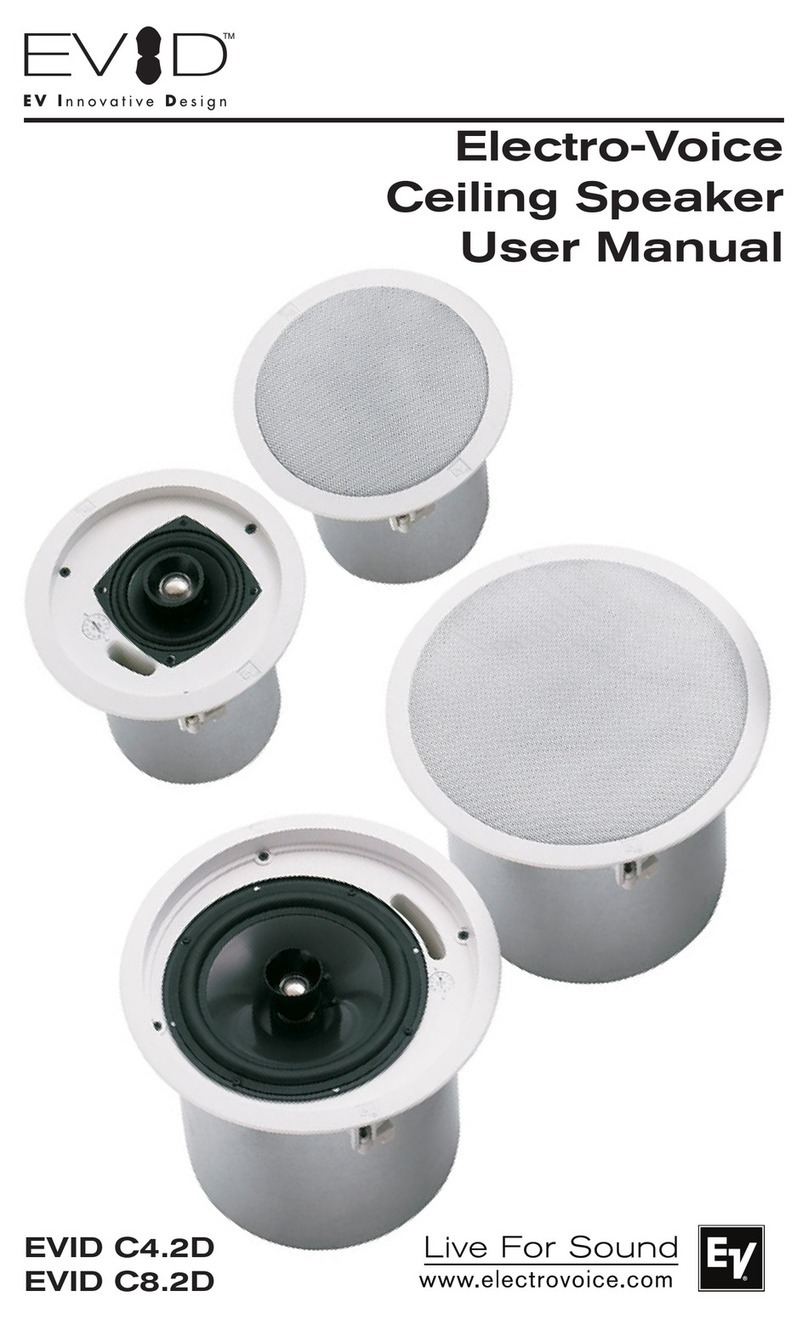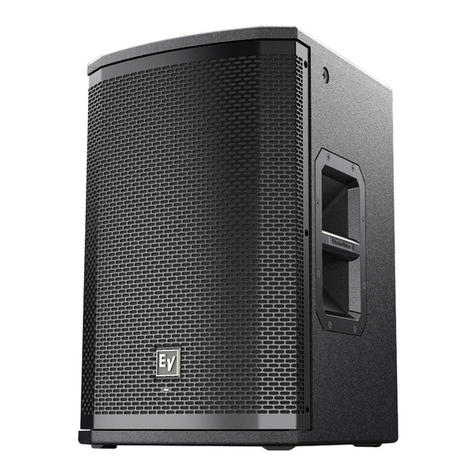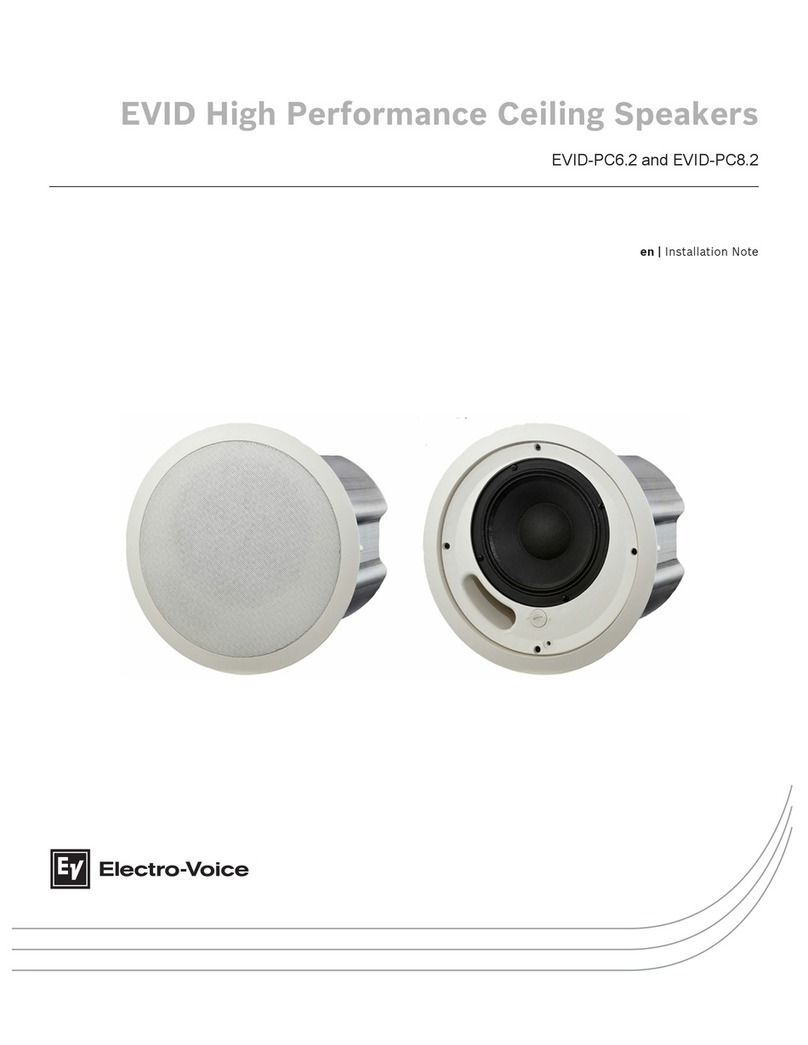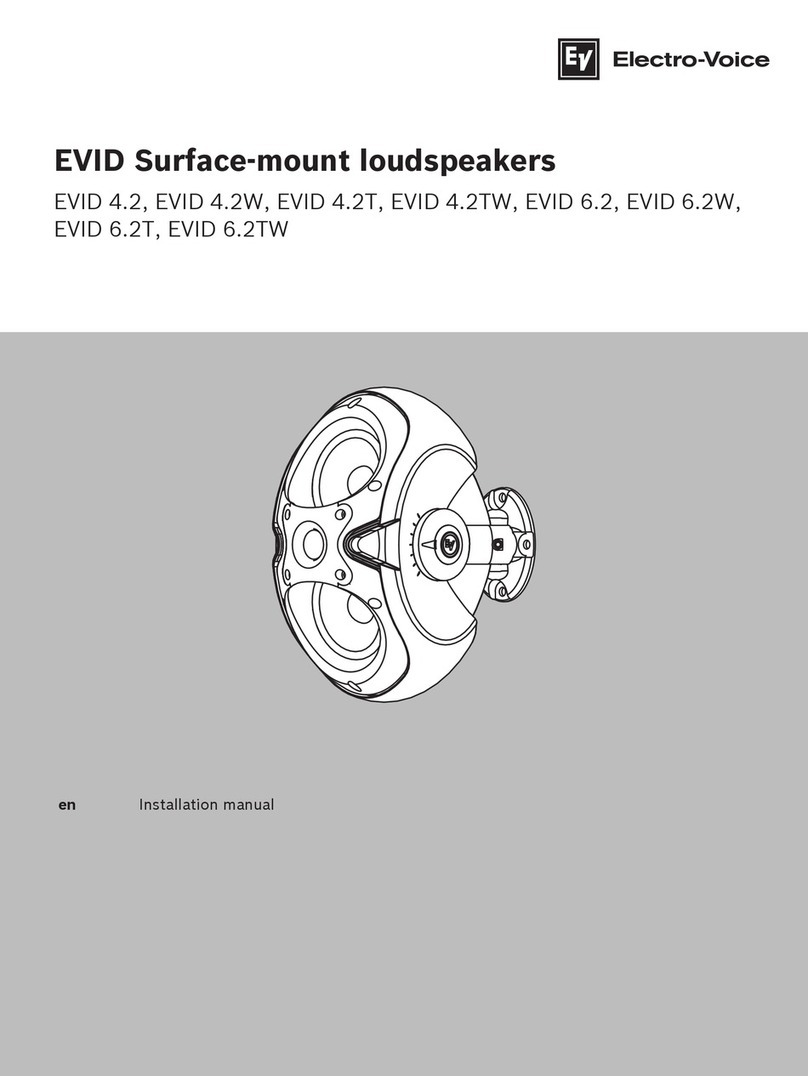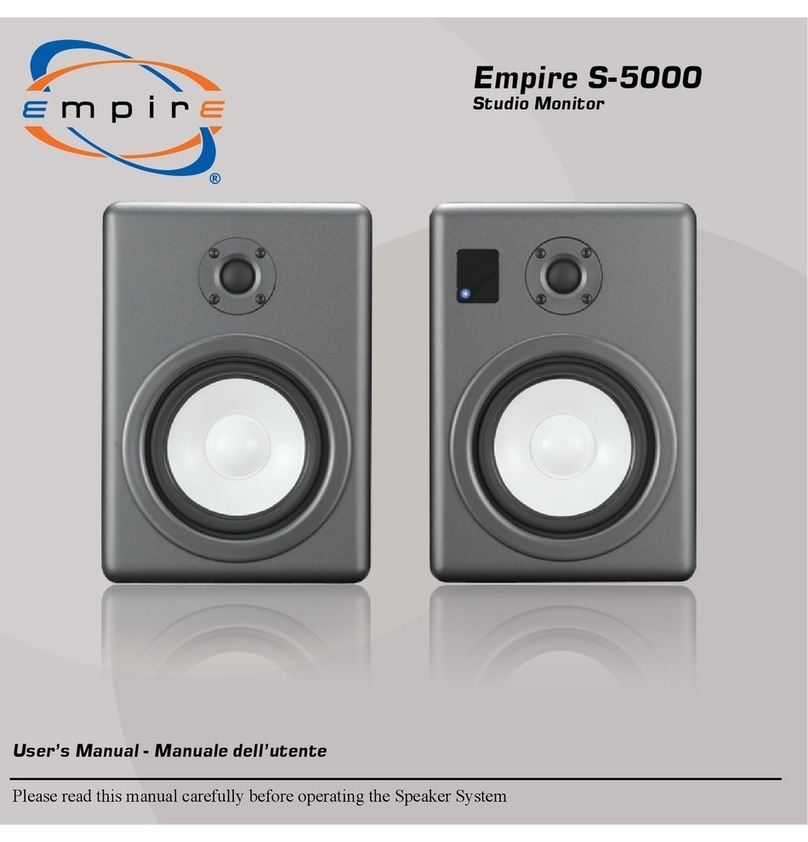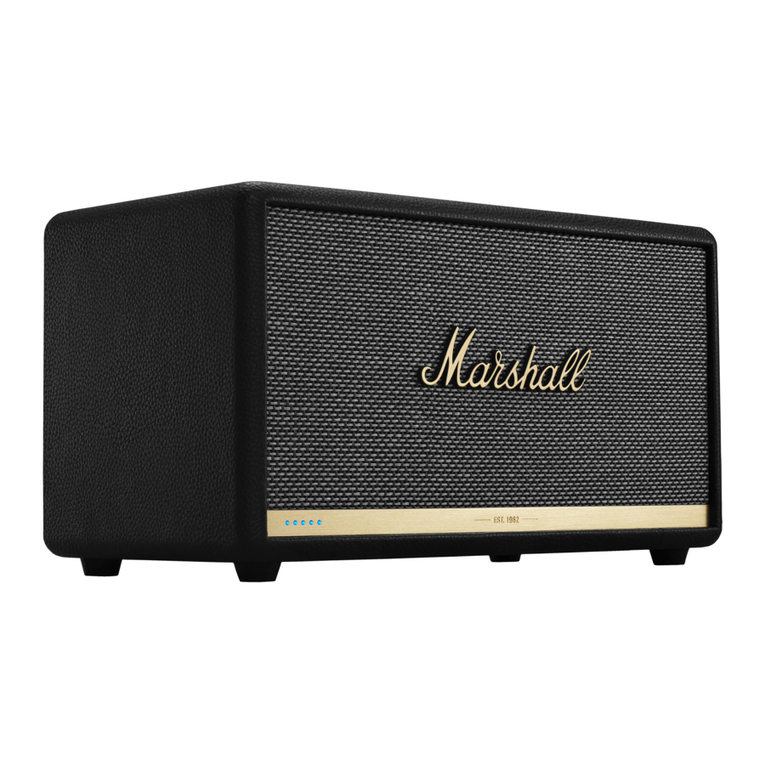CROSSOVER, EQ AND SIGNAL
DELAY
The PIM-252 is a two-way system which must
be
biamped with aseparateactive crossover.A
1
,200-Hzcrossoverfrequencyis recommended.
Optimum performance and reliability are pro-
vided by 24-dB-per-octave slopes. 12-dB-per-
octave slopes are the minimum recommended.
The low-frequency section should have sub-
passbandprotection usinga high-pass filter set
at about30 Hz.No signal delay orfurther EO is
mandatory but their use can smooth response
anddirectivity,particularly
in
theregion ofcross-
over. The high-frequency section requires the
appropriate constant-directivity-horn high-
frequency boost EO for flat response.
The Dx34 digital speaker system processor
can be set to provide subpassband protection,
crossover, EO and signal delay for optimum
performance of the PIM-252. Contact Electro-
Voice forthe specificparametersettings.Alter-
natively, the XEO-2 or XEO-3 analog cross-
over/equalizer/delay networks can be used.
High-frequency horn EO is provided by plug-in
modules, the specific model of which is deter-
minedbythe horn model. TheXEOengineering
data sheets provide this specific information.
LOW-FREQUENCY ENHANCEMENT
If it is desirable to enhance low-frequency per-
formance, Electro-Voicerecommends, depend-
ingon installation requirements, the PIM-151 or
PIM-251
PI
Matrix Series™ systems as well as
any of the TL series
or
MTL series of Manifold
Technolog~
systems. Contact Electro-Voice
for information on these systems.
FREQUENCY RESPONSE
PIM-252 axial frequency responses were mea-
sured in Electro-Voice's large anechoic cham-
ber at a distance of 3.0 meters (10 feet) with
swept sine-wave input. Figure 2 shows the
typical overall system response with presets of
the Dx34 digital speaker system processor.
Speakerdrivevoltage is4voltsat1kHz.Figure
3 shows the responses of the individual low-
and high-frequencysections with a4-voltdrive,
normalized for a
l-watt
input and a
l-meter
distance.
DIRECTIVITY
The directional characteristics
of
the PIM-252
were
measured
in
Electro-Voice's
large
anechoic chamber, with a test signal of one-
third-octave filtered pink noise at the frequen-
cies indicated. Presets for the Dx34 digital
speaker system processor were employed. A
full spherical measurement system, which is
fully compatible with Mark IV Audio's Acousta-
CADDTM
computer aided design program, was
used.All directional information was measured
at
6.1
meters (20 feet).
Figure 8 illustrates the nominal horizontal and
vertical polar responses, with the long system
axis vertical. If the high-frequency horn is ro-
tated, then the horizontal and vertical polars
should be interchanged.
Figure 4 illustrates the horizontal and vertical
beamwidths. Beamwidth is the angle at which
the horizontal and vertical polar responses
have decreased in level by 6-dB when com-
pared to the on-axis frequency response.
Figure 5 represents the total directivity of the
PIM-252. The directivity factor, Rs (0), is the
relative value,at a point, when compared to an
ideal spherical response. The directivity index
(D) is calculated by
D,=1010g
lO
R.
SERVICE
In
the unlikely event the PIM-252 requires ser-
vice, each driver can be replaced
or
serviced
from the front. A service data sheet is available
from Electro-Voice.
POWER-HANDLING TEST
Electro-Voice components and systems are
manufactured to exacting standards, ensuring
they will hold up, not only through the most
rigorousofpowertests, butalsothrough contin-
ued use in arduous, real-life conditions. Two
main test specifications are used: the AES
Recommended Practice for Specification of
LoudspeakerComponentsUsedin Professional
Audio and Sound Reinforcement (AES2-1984/
ANSI S4.26-1984) and the EIA Loudspeaker
PowerRating Full Range (EIA RS-426-A 1980).
Both of these specifications use random-noise
spectrum which mimicstypical musicand tests
the thermal and mechanical capabilities of the
components. Electro-Voicewill supportrelevant
additional standardsas and when they become
available.Extreme, in-housepowertests,which
push the performance boundaries of the com-
ponents, are also performed and passed to
ensure years of trouble-free service.
Specifically, the PIM-252 high-frequency sec-
tion passes AES2-1984/ANSI S4.26-1984 with
the following values:
Zm;n
= 6.3 ohms at 6,000 Hz
P
E(max) = 75 watts
Test voltage = 21.7 volts rms
43.5 volts peak (+6 dB)
Selected decade = 1,500-15,000 Hz
The PIM-252 low-frequency passes EIA
RS
-
426-A 1980 with the following values:
RSA
= 3.45 ohms (1.15 x RE)
PE(m
..
) = 800 watts
Test voltage = 52.5 volts rms
105 volts peak (+6 dB)
ARCHITECTS'
AND
ENGINEERS'
SPECIFICATIONS
Theloudspeakershallbe atwo-waydualwoofer
system for biamplification. Low frequencies
shall be reproduced by two 8-ohm 381-mm
(15-in.) woofers with an edge-wound flat-wire
63.5-mm
(2
.5-in.) voice coils capable of han-
dling a total of800 watts long term per EIA RS-
426-A and with a sensitivity of
101
dB 1 waW
1 meter. High frequencies shall be reproduced
by
an
8-ohm
compression
driver
with a
76.2-mm (3-in.)diaphragm and a51-mm (2-in.)
exit, capable of handling 75 watts long term per
AES2-1984/ANSI S4.26-1984, coupled to a
constant-directivity horn with a 60° x 40° cover-
age pattern andwith asensitivityof 112dB.The
high-frequencyhornshallbe rotatable 90°about
its axis within the enclosure. The system shall
reproduce frequencies from 45 to 18,000 Hz
and have a nominal coverage pattern of 60° x
40°, with directivity control maintained down to
500
Hz.
Therecommended crossoverfrequency
shall be 1,200 Hz. Maximum average sound
pressure levelsat 1metershall be 130 dB (low-
frequencysection) and
131
dB (high-frequency
section), with short-term peaks 6 dB higher.
The enclosure shall be constructed of 7-ply
void-free birch and finished in black textured
paint. The enclosure shall have a trapezoidal
footprint. Dimensions shall be 1.32 m (51.9
in
.)
high, 575 mm (22.7 in.) wide at the front,
359 mm (14.1
in
.) wide at the rear and 438 mm
(17.2 in.) deep. Enclosure sides shall have a
15° draft angle. The enclosure shall have a
suspension system approved by an indepen-
dentstructural engineerand consisting of three
independent suspension points on the top and
three independent suspension on the bottom,
all of which shall mate with Ancra 42546-10
fittings. Net weight shall be 61.2 kg (135 Ib).
The loudspeaker system shall be the Electro-
Voice PIM-252.
Note: The PIM-252
described
sbove
Is the
standard
configuration.
Acoustic
and
me-
chanlcsl
details
wl1l
vary
when
different
options
sre
supplied.
UNIFORM LIMITED WARRANTY
Electro-Voice products are guaranteed against
malfunction dueto defects in materials orwork-
manship for a specified period, as noted
in
the
individual product-line statement(s)below, or
in
the individual product data sheet or owner's
manual,beginning with the date of original pur-
chase. If such malfunction occurs during the
specified period, the product will be repaired or
replaced (at our option) without charge. The
product will be returned to the customer pre-
paid.
Exclusions
and
Limitations:
The
lim-
ited Warranty does not apply to: (a) exterior
finish or appearance; (b) certain specific items
described
in
the
individual
product-line
statement(s) below, or
in
the individual product
data
she-et
or owner's manual; (c) malfunction
resulting from use or operation of the product
otherthan
as
specified in the productdatasheet
or owner's manual; (d) malfunction resulting
from misuse or abuse of the product; or (e)
malfunction occurring at any time after repairs
have been made to the productbyanyoneother
than Electro-Voice or any of its authorized ser-
vice representatives.
Obtaining
WarrantyS
....
vice: To obtain warranty service, a customer
must deliver the product, prepaid, to Electro-
Voice oranyofits authorized service represen-
tatives together with proof of purchase of the
product
in
the form of a bill of sale or receipted
Invoice.A list of authorized service representa-
tives is available from Electro-Voice at 600
Cecil Street, Buchanan,
MI
49107 (616/695-
6831
or800/234-6831).
Incidental
and
Conse-
quential
Damages
Excluded:
Product repair
or replacement and return to the customer are
the only remedies provided to the customer.
Electro-Voiceshall notbe liable foranyinciden-
tal orconsequential damages including,without
limitation, injUrytopersons orpropertyorlossof
use. Some states do not allow the exclusion or
limitation of incidental or consequential dam-
ages so the above limitation or exclusion may
not apply to you.
Other
Rights:
This warranty
givesyou specificlegal rights,and you mayalso
haveotherrights which vary from state
to
state.
Electro-Voice
Speakers
and
Speaker Sys-
tems
are guaranteed against malfuncti
on
due
to defects in materials or workmanship for a
period of five (5) years from the date of original
purchase.The Limited Warrantydoes notapply
to burned voice coils
or
malfunctions such as
cone and/orcoil damage resulting from improp-
erly designed enclosures. Electro-Voice active
electronics associated with the speaker sys-
tems are I;juaranteed forthree (3) years from the
date of onginal purchase.Additional details are
included in the Uniform Limited Warrantystate-
ment.
Electro-Voice
Flying
Hardware(includingen-
closure-mounted hardware and rigging acces-
sories) is guaranteed against malfunction due
to defects in materials or workmanship for a
period of one (1) year from the date of original
purchase. Additional details are included in the
Uniform Limited Warranty statement.
Electro-Voice
Accessories
are guaranteed
against malfunction due to defects in materials
orworkmanship for aperiodofone (1) yearfrom
the date of original purchase. Additional details
are included in the Uniform Limited Warranty
statement.
Service and repair address for this product:
Electro-Voice, Inc.,600 Cecil Street,Buchanan,
Michigan 49107 (616/695-6831 or 800/234-
6831).
SpeCificationssubject to changewithoutnotice.
IEtI
ELECTRO·
VOICE a MAR. IV
company
600
Cecil
Street,
Buchanan,
Michigan
49107
MANUFACTURING
PLANTS
AT
•
BUCHANAN
,
MI
•
NEWPORT,
TN
•
..
S.
EVIERVILLE
,
TN
•
OKLAHOMA
CITY
,
OK
•
GANANOQUE
,.
ONT
.
®
iC)
Electro-Voice,
Inc
.
1995
•
Litho
in
U.
S.A.
. .
Part
Number
532704
-
9533
.........
';,>:';;;:,:;,,;,;,.;.,.,.,.;.,.;.;.....
:.;,
